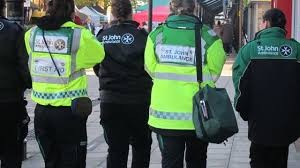 Leading first aid charity St John Ambulance is urging everyone to learn basic first aid skills ahead of Bonfire Night as shocking statistics reveal a third of parents and grandparents have witnessed an injury during bonfire night celebrations and 4,506 people visited A&E from 2014-2015 for treatment of a firework-related injury. This is a huge 111 per cent increase from the 2,141 firework-related injuries reported in 2009-10.
Leading first aid charity St John Ambulance is urging everyone to learn basic first aid skills ahead of Bonfire Night as shocking statistics reveal a third of parents and grandparents have witnessed an injury during bonfire night celebrations and 4,506 people visited A&E from 2014-2015 for treatment of a firework-related injury. This is a huge 111 per cent increase from the 2,141 firework-related injuries reported in 2009-10.
The most common injuries that St John Ambulance volunteers are required to treat at Bonfire Night gatherings are burns, debris in the eye from bonfires and fireworks, and smoke inhalation.
St John Ambulance volunteers will be attending firework events across the country so that anyone who needs first aid gets it quickly. However, injuries are much more likely to occur at private parties, where trained volunteers won’t be on hand to help, highlighting the need for those attending firework events to learn basic first aid to ensure they can be prepared to help in a firework first aid emergency.
Burns or scalds
If someone’s got a burn or scald:
- Run it under cold water for at least ten minutes. You need to completely cool their skin to prevent pain, scarring or further damage
- If the burn is on a child, or if you think it’s a serious burn (for example, if it’s deep, larger than the size of their hand, or on the face, hands or feet) call 999/112 for an ambulance
- Remove any jewellery or clothing near the burn (unless they’re stuck to it)
- Don’t pop any blisters or apply ice, cream or gel – this can make it worse
- Once cooled, cover the burn with cling film or a plastic bag
- If necessary, treat them for shock, by laying them down with their legs raised and supported above the level of their heart
Debris in the eye
If someone’s got something in their eye:
- Tell them not to rub it, so they don’t make it worse
- Pour clean water over their eye to wash out what’s in there and/or to cool the burn
- If this doesn’t work, try to lift the debris out with a damp corner of a clean tissue
- If this doesn’t work either, don’t touch anything that’s stuck in their eye – cover it with a clean dressing or non-fluffy material
- Then take or send them straight to hospital
Smoke inhalation
If someone’s inhaled smoke fumes:
- Move them away from the smoke so they can breathe in some fresh air
- Help them sit down in a comfortable position and loosen any tight clothing around their neck to help them breathe normally.
- If they don’t recover quickly, call 999/112 for an ambulance
For first aid information, visit www.sja.org.uk for more first aid tips. People can also download the free St John Ambulance first aid app (available for iPhone and Android devices). It can be used to provide support while waiting for help to arrive. The app features easily accessible step-by-step information, an intuitive interface and voice prompts for several first aid techniques.
